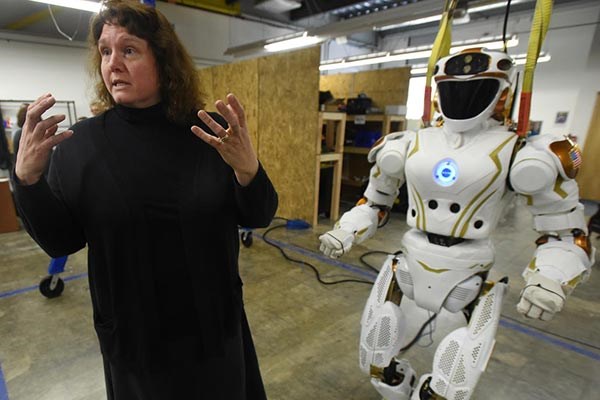 Image by Patrick Whittemore/Boston Herald
Image by Patrick Whittemore/Boston Herald
QUITE A RIDE: NERVE Center Director Holly Yanco, above, works at University of Massachusetts Lowell with Val — short for Valkyrie — to improve the robot’s communication skills.
04/07/2016
Boston Herald
By Jordan Graham
Years from now, a robotic astronaut named Val could walk across the dusty Martian terrain to greet a spaceship carrying humans ready to colonize the Red Planet.
How well the robot does that job will fall to some Bay State universities, who are playing a key role in teaching Val how to be an astronaut’s best friend.
“What she will be able to do, hopefully, is just about everything that a suited astronaut in a planetary field could do,” said Kris Verdeyen, NASA project manager for Val. “This is NASA’s first foray into a bipedal motion robot, so we’re basically learning the ropes as we go.”
Val — short for Valkyrie — is a 6-foot, 2-inch, 300-pound mass of metal, wires and plastic that was delivered to University of Massachusetts Lowell at 6:30 yesterday morning, along with a squad of NASA engineers, who put together the robot piece by piece.
A team of UMass Lowell and Northeastern University researchers will spend the next two years writing software and algorithms to improve Val’s walking, hand coordination and communication. The distance from Earth to Mars means any communication with the robot would be significantly delayed, so manually operating Val is impractical.
“Every 20 minutes you can say, ‘Check out panel A,’ or, ‘Replace panel A,’ and a robot will have to figure out how to do it, have to do it reliably and fast,” said Taskin Padir, a Northeastern professor. “Robots are still slow and they still need supervision from humans. Our goal is to take steps toward making these systems more autonomous.”
This version of Val — one of four in the world — will live at UMass Lowell’s NERVE Center. One will stay with NASA, while the other two will go to the Massachusetts Institute of Technology and the University of Edinburgh.
Holly Yanco, director of the NERVE Center, said her work will focus on improving Val’s communication with the humans giving her directions, including knowing how to give relevant information when the robot runs into a problem.
“Val might be able to send back a few short video clips and explain what she’s been trying to do and maybe what the problem is,” Yanco said. “Right now, it doesn’t have a lot of autonomy, and that’s some of the stuff we’ll be developing.”
Val looks straight out of science fiction with a black helmet shield, hulking calves and a circle of lights on her chest. The lights are a status sign for people near the robot, but also serve another purpose.
“If you’re going to have something working around people, having it not terrify them is probably a good first step,” Verdeyen said. “One of our design goals has always been, this better look cool.”
